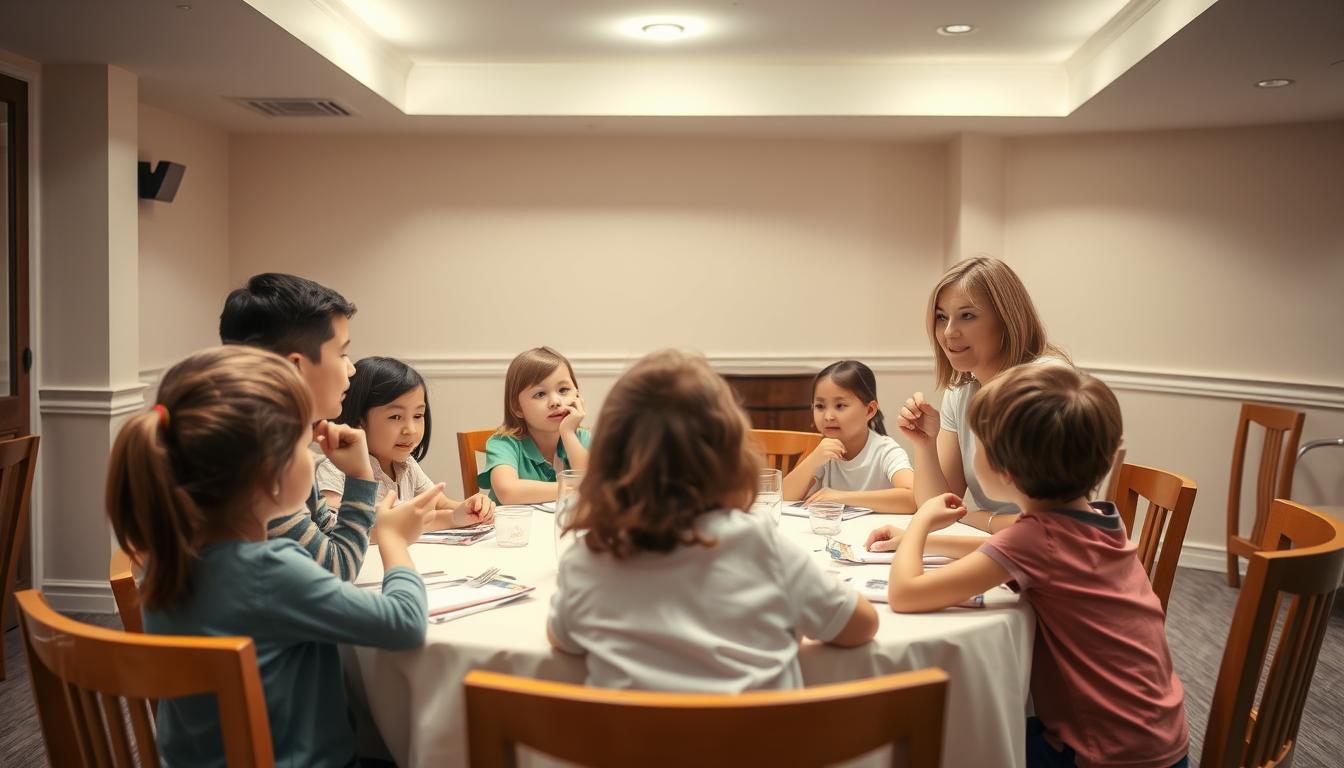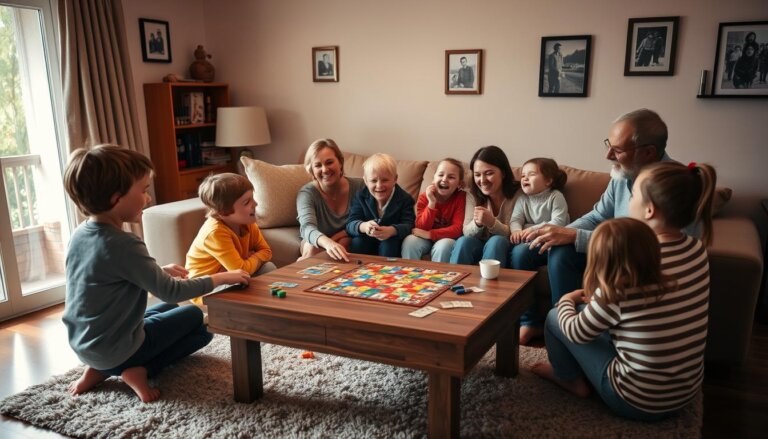How to Teach Kids Public Etiquette Without Yelling
You’re in the grocery store, and your child is throwing a tantrum. You feel like yelling, but it doesn’t help. In fact, it usually makes things worse.
Effective ways to teach kids etiquette are out there. You can teach your child good manners and how to behave in public. It’s about being calm and respectful, not avoiding the problem.
Learn how to help your child behave better without yelling. This can make your family life more peaceful.
The Public Meltdown Scenario: You’re Not Alone
Standing in a crowded store, trying to manage a child’s meltdown is tough. Many parents face this challenge. It’s especially hard when teaching polite behavior for kids in chaotic situations.
Public places overwhelm kids with too much to see and hear. This can cause tantrums. Parents need strategies to manage these moments and teach etiquette lessons for youngsters.
When Kids Lose Control in Public Places
Children often lose control in public due to too much stimulation, tiredness, or frustration. Knowing these triggers helps parents teach etiquette tips better. By spotting tantrum signs early, parents can act fast.
| Trigger | Pre-tantrum Signs | Parental Action |
|---|---|---|
| Overstimulation | Restlessness, irritability | Find a quieter area |
| Tiredness | Yawning, rubbing eyes | Plan for rest |
| Frustration | Fussing, complaining | Offer empathy and solutions |

The Parental Pressure Cooker: Why We Feel Compelled to Yell
The need to control and ensure good behavior can feel overwhelming. This stress, added to the public setting, might make parents yell. But yelling can harm efforts to teach polite behavior for kids.
Understanding both the child’s actions and the parent’s stress is key. This helps find better ways to teach etiquette lessons for youngsters that work better and are less stressful for everyone.
Why Yelling Fails as a Teaching Tool
Parents often yell at their kids in public, thinking it’s effective. But research shows it has the opposite effect. When teaching children’s manners education, how you approach it is key. Yelling might stop the behavior for a moment, but it doesn’t teach why it was wrong or how to behave right next time.
The Science Behind Children’s Responses to Tone vs. Volume
Research shows kids respond more to the tone of voice than the volume. A gentle, calm tone is more effective in getting a child’s attention and encouraging good behavior. This is because kids are more attuned to the emotional nuances in tone, helping them understand the message’s context and significance.
When parents yell, the loud volume can be startling or even frightening. But it doesn’t convey the intended lesson well. Instead, it can cause confusion and anxiety, making it harder for kids to learn polite communication skills.
How Yelling Reinforces Negative Behavior Patterns
Yelling can inadvertently reinforce the behaviors parents are trying to correct. When kids are scolded loudly, they may become more aggressive or withdrawn. This is partly because yelling models the behavior it’s trying to stop, teaching kids that loud, aggressive communication is okay.
To effectively teach kids social skills, parents should use positive reinforcement and calm communication. This creates a safe environment where kids can learn and practice good manners. It leads to better outcomes in children’s manners education.
Connection Before Correction: A New Approach
To teach kids public etiquette without yelling, we must first understand that connection is key. This approach focuses on creating a foundation for respectful communication. It’s about building a strong base, not just correcting behavior.
Understanding your child’s developmental readiness for etiquette is crucial. Children develop at different rates. What works for one child may not work for another. It’s essential to assess your child’s emotional and cognitive development to determine the best approach for teaching etiquette.
Understanding Your Child’s Developmental Readiness for Etiquette
Children’s ability to understand and practice etiquette is closely linked to their developmental stage. For instance, younger children may struggle with impulse control. Older children may be more capable of understanding social norms.
| Developmental Stage | Etiquette Skills | Parental Strategies |
|---|---|---|
| Toddlers (1-3 years) | Basic manners like saying “please” and “thank you” | Model the behavior, positive reinforcement |
| Preschoolers (3-5 years) | Sharing, taking turns, basic table manners | Role-playing, gentle reminders |
| School-age children (6-12 years) | More complex social skills, like greeting others, using polite language | Discussing social norms, practicing in different contexts |
Building the Foundation for Respectful Communication
Building a foundation for respectful communication involves more than just teaching etiquette. It’s about creating an environment where your child feels heard and understood. This can be achieved by actively listening to your child, validating their feelings, and modeling the behavior you want to see.
By focusing on connection before correction, you can create a more positive and effective learning environment for your child. This approach not only teaches etiquette but also fosters a deeper, more respectful relationship between you and your child.
Preparing Kids for Public Success: Prevention Strategies
Teaching your child to behave well in public is key. By getting them ready ahead of time, you can lower the chance of tantrums and bad behavior.
Setting Clear Expectations Before Leaving Home
Before you go out, make sure your child knows what’s expected of them. Talk about parenting etiquette tips like staying by your side, not interrupting, and being polite. Making a checklist together can be fun and help them remember.
| Expected Behavior | Why It Matters | Tips for Encouraging It |
|---|---|---|
| Staying close to you | Safety and respect for others | Hold hands, explain why it’s necessary |
| Not interrupting others | Shows respect for others’ conversations | Practice waiting for your turn to speak |
| Using polite language | Demonstrates good manners | Model polite language yourself, praise their efforts |
Role-Playing Public Scenarios in Safe Environments
Playing out public scenes at home is a great way to teach etiquette lessons for youngsters. It makes them more confident and ready for real-life situations. For example, you can practice going to a restaurant or a store.
By setting clear rules and practicing, your child will learn polite behavior for kids. This helps them in many public places. It also makes things easier for you and your child, and helps them respect others.
How to Teach Kids Public Etiquette Without Yelling: The Core Principles
Teaching kids good manners is all about a few key principles. It’s possible and more effective to teach them without yelling. By focusing on these principles, parents can help their children learn and grow in a supportive environment.
One key element is making learning fun and consistent. It’s not just about telling kids what to do. It’s also about showing them how to do it.
Modeling the Behavior You Want to See
Children learn a lot from the adults they see. So, it’s important to model good behavior. When you’re out in public, act with the manners you want your child to have. Say “please” and “thank you,” hold doors open, and be respectful.
Explaining why certain behaviors are important is also crucial. For example, holding the door for someone shows respect and appreciation. This helps kids see how their actions affect others.
Consistency and Repetition: The Twin Pillars of Learning
Consistency and repetition are vital for reinforcing good manners. By consistently showing that good manners are valued, kids learn to adopt them. Repetition helps make these behaviors second nature.
To be consistent, set clear expectations and make sure everyone agrees. Use role-playing at home to practice different social situations. Praise good behavior and gently correct bad behavior without yelling.
By following these principles—modeling good behavior and being consistent and repetitive—parents can teach kids etiquette without yelling. This helps children become respectful and considerate individuals.
Strategy1: The Whisper and Redirection Methods
Raising well-mannered kids in public is possible with calm strategies. The whisper and redirection methods are effective. They help teach kids to behave well without yelling.
Why Lowering Your Voice Commands More Attention
Lowering your voice gets your child’s attention. Kids often think loud voices mean anger. A soft voice is a nice change.
Whispering avoids yelling and makes for a closer and focused talk. It’s great in public to keep things polite.
By whispering, you show your child how to speak softly. They might start to do the same. This makes for a more polite and respectful interaction.
Shifting Focus Without Confrontation
Redirection is key in teaching kids to behave in public. It helps avoid tantrums and meltdowns. You can change the topic or activity to do this.
For example, if your child gets restless in a store, show them something interesting. Or play a game that keeps them busy. This distracts them from their frustration and keeps them engaged.
Using the whisper and redirection methods helps a lot. They reduce public meltdowns and teach kids to behave well. These strategies promote polite communication with children and make public interactions better.
Strategy2: The Connection and Empathy Approach
Using a connection and empathy approach helps your kids learn good manners. It builds a strong bond between you and your child. This makes them more open to learning and using good manners.
Taking a Moment for Physical Reassurance
Physical reassurance is key in teaching children manners. A hug or a reassuring touch can calm them down. This makes them more ready to listen to you.
For example, if your child throws a tantrum in a store, a hug can help. It’s important to be calm and gentle. This shows them the right way to behave.
Acknowledging Feelings Before Addressing Behavior
It’s important to acknowledge your child’s feelings. When they feel understood, they’re more likely to listen. For instance, if they can’t have a toy, say, “I see you’re upset. It’s frustrating when we can’t get what we want.”
Then, you can talk about the behavior. This teaches them that their feelings are valid. It also guides them to better behavior in public.
Using this approach in parenting makes a positive environment for your child. It improves their manners and strengthens your bond.
Strategy3: Positive Reinforcement in Public Settings
Teaching your child good manners in public is easier with positive reinforcement. This method encourages good behavior instead of just correcting bad ones. It helps your child feel responsible and respectful towards others.
Positive reinforcement works because it rewards good actions. When your child uses good manners, like saying “please” or waiting their turn, praise them. A simple “I’m proud of you” or “Great job!” can go a long way.
Catching Good Behavior in the Act
It’s important to praise good behavior right away. When you see your child acting well in public, like waiting patiently, praise them. This can be at the grocery store, a restaurant, or a family event. Be specific with your praise to show them what they did right.
For example, if your child waits quietly while you shop, say, “I really appreciate your patience. That’s very helpful.” This specific praise helps them understand what’s expected and encourages them to keep it up.
Creating Incentive Systems That Actually Work
Setting up an incentive system can motivate your child to behave well in public. You could use a reward chart where they get stickers or stars for good behavior. When they collect enough, they can trade them for a reward.
When creating incentives, choose rewards that are meaningful and achievable. For young kids, stickers or small treats work well. For older kids, bigger rewards like extra privileges or outings might be more appealing. The key is to be consistent and make sure the rewards match the behavior.
By using positive reinforcement, like praising good behavior and setting up incentives, you can teach your child important parenting etiquette tips. These etiquette lessons for youngsters will help them handle different social situations with confidence and respect.
Strategy4: Natural Consequences and the Preparation-Practice-Praise Cycle
Parents can teach kids about public etiquette by using natural consequences and a practice cycle. This method helps kids see how their actions affect others. It also prepares them for different social situations.
Teaching Through Real-World Outcomes
Natural consequences teach kids from their mistakes safely. For example, if a child doesn’t hold hands in a crowd and gets lost, they learn a valuable lesson. It’s important for these consequences to teach, not punish too much.
When kids see the results of their actions, they change their behavior. This way, they think about their actions and choose better ones next time.
Setting Up Graduated Challenges for Success
The preparation-practice-praise cycle helps teach social skills and politeness. It starts with preparing kids for a situation and then practicing it at home. This could be through role-playing different scenarios.
As kids get more confident, they face tougher challenges, like eating at a restaurant. Praising their efforts and successes helps them keep improving.
By using natural consequences and the preparation-practice-praise cycle, parents can teach kids how to behave in public. This method helps fix bad behavior and builds confidence and skills for polite interactions.
Conclusion: Raising Well-Mannered Children Through Calm Guidance
Teaching kids good manners without yelling is possible. Use calm guidance and positive words to help your child. This way, they learn to respect others and behave well in public.
Setting clear rules and showing good behavior yourself helps a lot. The whisper and redirection methods, and positive reinforcement, are great tools. They help your child learn to behave in public without yelling.
Don’t worry if it seems hard. You’re helping your child deal with social situations. With patience and consistency, they’ll learn to be confident and respectful in public. Using these strategies will help you raise a well-mannered child ready for any social situation.
FAQ
What is the best way to teach children manners without yelling?
To teach children manners without yelling, model the behavior you want to see. Be consistent and use positive reinforcement. This calm approach helps them learn good manners.
How can I help my child understand the importance of public etiquette?
Explain the importance of public etiquette by setting clear expectations before going out. Role-play public scenarios in safe places. Tell them why certain behaviors are expected in public.
What are some effective strategies for teaching kids polite behavior?
Effective strategies include whispering and redirecting, using empathy, and positive reinforcement in public. Also, natural consequences and the preparation-practice-praise cycle work well.
These methods help your child develop good manners and polite behavior in public.
How can I prepare my child for public success?
Prepare your child for public success by setting clear expectations and role-playing. Use positive reinforcement to encourage good behavior.
What is the role of consistency and repetition in teaching kids etiquette?
Consistency and repetition are key in teaching kids etiquette. They reinforce good behavior and create a supportive, predictable learning environment.
How can I teach my child to manage their emotions in public?
Teach your child to manage emotions in public by offering physical reassurance. Acknowledge their feelings before addressing their behavior. Also, model healthy emotional regulation yourself.







